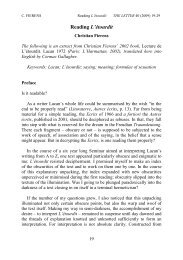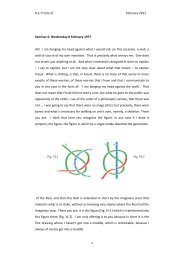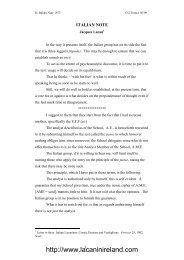Seminar XXIV Final Sessions 1 - Lacan in Ireland
Seminar XXIV Final Sessions 1 - Lacan in Ireland
Seminar XXIV Final Sessions 1 - Lacan in Ireland
You also want an ePaper? Increase the reach of your titles
YUMPU automatically turns print PDFs into web optimized ePapers that Google loves.
all be superimposed on the one who produces on the stage and I return to Bozef.And on that I end.Bozef therefore, at S(Ø) is <strong>in</strong> the position of be<strong>in</strong>g a Passer, but he is not <strong>in</strong> theposition of bear<strong>in</strong>g witness from where he is pass<strong>in</strong>g. What can account for hisposition, I ask you, from where he speaks, if not this concatenation of graphs thatI have drawn for you – I unfortunately was not able to f<strong>in</strong>ish them – that I drewfor you on the board. If this hypothesis is true, namely, if the Passer, this writ<strong>in</strong>g,these graphs function as Passers <strong>in</strong> that they testified from the locus ofenunciat<strong>in</strong>g strictly articulated to enunciation which is the Passer, s<strong>in</strong>ce it is notBozef? I would simply answer and I would say that fundamentally the Passer isthe writer of the one who has put <strong>in</strong> place, who has written this writ<strong>in</strong>g, thesegraphs. I would even say that the example, if <strong>Lacan</strong> says he never ceases pass<strong>in</strong>gthe pass it is perhaps for this reason; he does not cease and we can imag<strong>in</strong>e thathe will never cease; he does not cease because sem<strong>in</strong>ar after sem<strong>in</strong>ar he creates,he resurrects the Passer, which is his writ<strong>in</strong>g, namely, that he creates theconditions of his division. He creates like Bozef at a given moment on his journeywith his back to the wall, puts himself <strong>in</strong> the place of the transmitter <strong>in</strong> order tomake himself at the same time an emitter and a transmitter <strong>in</strong> the violet arrowwhen he renounces the <strong>in</strong>termediary, <strong>Lacan</strong>, sem<strong>in</strong>ar after sem<strong>in</strong>ar, creat<strong>in</strong>g andrecreat<strong>in</strong>g his Passer, can effectively not cease to pass the pass, all the more sothat the Other to whom he addresses himself is certa<strong>in</strong>ly not a jury from which heexpects some sort of Amen. Yes. I imag<strong>in</strong>e the negative reactions that will bethrown back at me, of say<strong>in</strong>g that a writ<strong>in</strong>g could play the function of a Passer fora jury; I <strong>in</strong>cidentally learned from Jean Clavreul, that this is a proposition that hehad made, some years ago, to th<strong>in</strong>k of this notion of a writ<strong>in</strong>g as a Passer; theobjection that will be made immediately to me is to say; to make a Passer out of awrit<strong>in</strong>g, effectively, is a matter then of mak<strong>in</strong>g a report, a report why not anacademic masters? Naturally, the response that I would give immediately to thiscontradictor, would be to say that if the one who writes, if the Other to whom headdresses himself is identifiable to a jury, effectively what he will produce willeventually effectively be perhaps an excellent report but effectively academic. If<strong>in</strong> this writ<strong>in</strong>g he bears witness, as I th<strong>in</strong>k I have tried to do, of the locus of theway <strong>in</strong> which an enunciation and an enunciat<strong>in</strong>g are articulated topologically <strong>in</strong> a80














